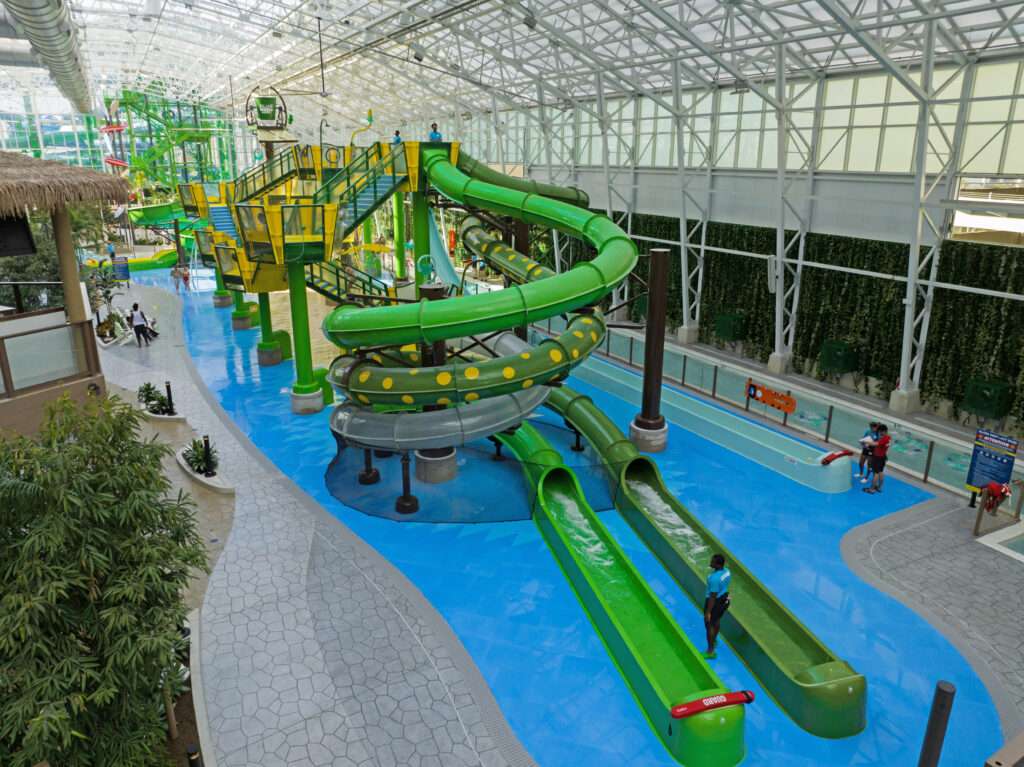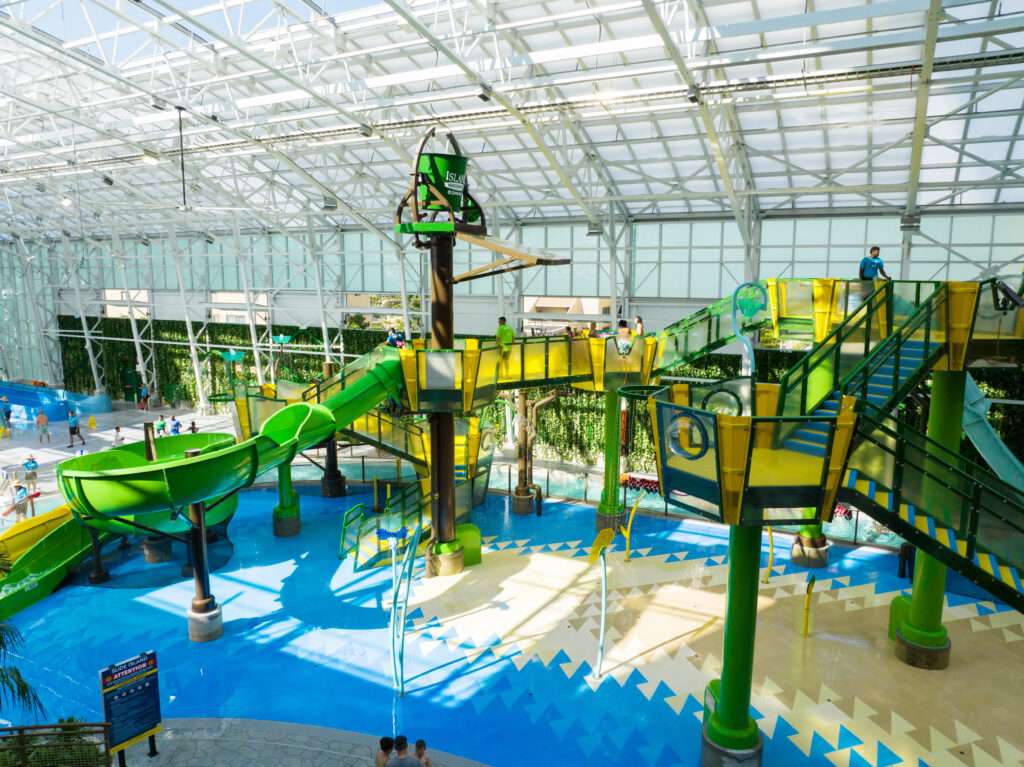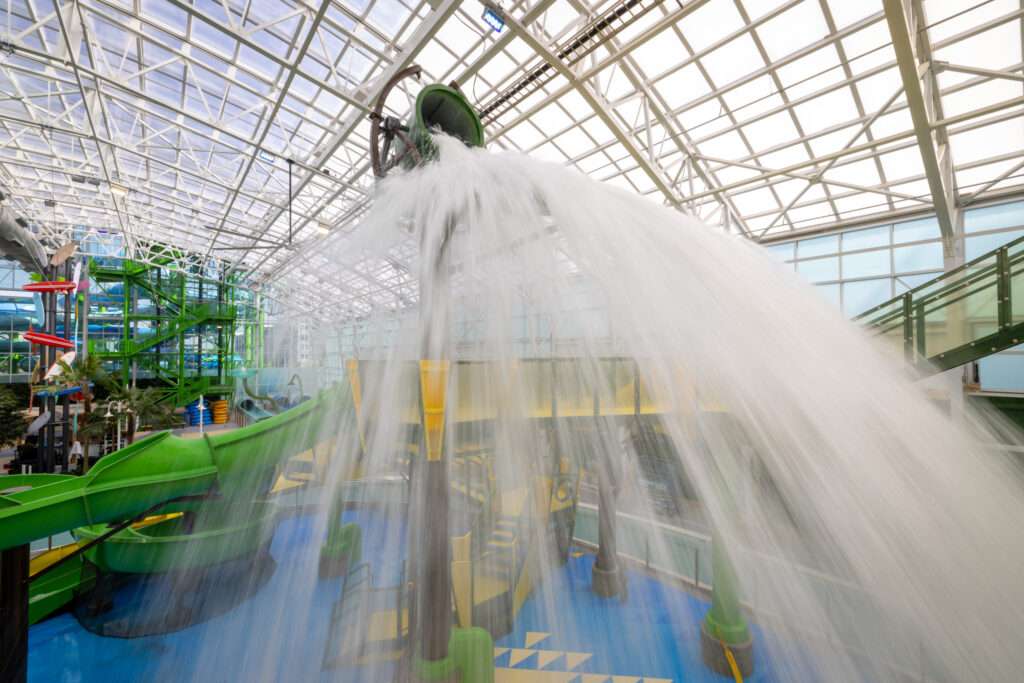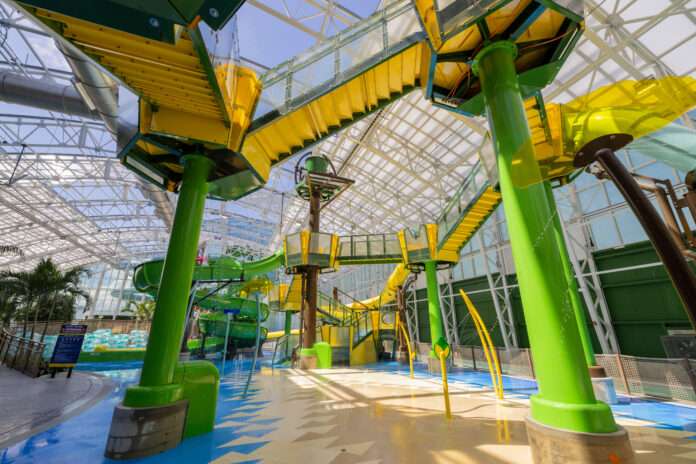Complete Kids’ Play Areas reflect a holistic approach
by Martin Palicki
The kids’ play area in waterparks is getting a makeover. Over decades they have grown to become a staple at waterparks, and now they are evolving to meet the changing needs of both operators and guests. The result is an even more family-friendly, integrated waterpark experience that also reflects the changing dynamics operators face.
As part of this renaissance, WhiteWater has developed the Complete Kids’ Play Area, with four components designed to elevate the art of waterplay for everyone. “We provide a whole solution for parks that includes all the elements of a traditional play structure, but makes it more appealing for families to enjoy together while also being easier to operate,” says Jordanna Bower, Vice President, Business Development for WhiteWater.
The Complete Kids’ Play Area includes adults
With a home office in Vancouver, Canada, and regional offices around the world, WhiteWater is perhaps best known for its lineup of thrilling waterslides and innovative, multi-level interactive attractions. But the company has also been a key supplier of waterplay areas for decades. They have seen firsthand how both guest and operator needs have evolved over time.


On the guest side, families today are looking for places where they can play together as a group. “Many parks were designed to serve young kids, teens and adults in different areas of the park,” says Mark Weston, Product Manager, Aquatic Play for WhiteWater. “But that doesn’t support the natural way family groups want to play.”
Not only do families want to enjoy time together, but there also must be spaces where the parents can relax while the kids play nearby. “You can have a great, well-thought-out area for kids to splash around in, but if parents don’t have a fun and comfortable place to relax, the family won’t be staying for long,” says Bower. That means having lots of seating, rental cabanas, nearby restrooms and a bar, all within view and earshot of the play area.
On the operator front, a lot of the change is being driven by personnel challenges. “Parks are having a significant staffing problem when it comes to finding lifeguards,” says Bower. “Older structures, typically built above a shallow pool of water with slides starting and ending in multiple locations, requires more lifeguards to cover the entire area.”
WhiteWater’s solution is the Complete Kids’ Play Area, consisting of four components: interactive play structures, spray toys, waterslides, and non-slip safety flooring. WhiteWater has focused on and enhanced each component in order to create an experience that is safer, more family-inclusive, higher-quality, and more engaging for everyone.
Play structures
WhiteWater recently added the new play structure AquaForms, a modular system with customizable activities and attractions. Unlike other play structures, AquaForms does not have set footprint sizes. The interchangeable components can be configured in virtually unlimited combinations for almost any space.

Instead of boxy support structures, AquaForms utilizes a monopole pedestal structure, allowing for up to 22 feet between supports. Guardrails are either clear or translucent, which, along with the minimal support structure, creates better sightlines for both lifeguards and parents. Cause-and-effect interactive play features combined with kinetic elements activate the experience, modernizing a proven piece of entertainment.
Spray toys
As a mother of two, Bower pays particular attention to the details of a play area and has used her insight to help WhiteWater craft better products. “I started noticing spray features that were exactly at eye height for my 2-year-old,” she explains. “Also, tipping buckets are fun, but they can really take a toddler by surprise with the amount of water crashing down; now we design to disperse the water over a larger area.”
Other unique enhancements include activation switches for spray toys that require no electricity, relying instead on water pressure and guest movement for activation.
Waterslides
Kids’ play structures can now feature smaller versions of WhiteWater’s popular waterslides. “We realized that creating junior versions of our rides just for younger kids creates a connection between kids of different ages,” says Bower.
Weston agrees: “Kids aspire to do the things older kids can. With our mini version of some of our iconic slides, a younger kid can ride the Mini Boomerango and share the same ride experience as their older sibling who rides the standard version. They can talk and bond over that experience of weightlessness.”
Life Floor
WhiteWater’s partnership with Life Floor (which began in 2018) is one effective way to maximize lifeguard effectiveness and reduce injuries at the same time. Designed for both safety and aesthetics, Life Floor is a soft surface that takes the place of a pool of water beneath a play area.

“One of the reasons we started working with Life Floor is because we realized that kids are just going to run no matter what you tell them, and eventually that leads to falling,” says Weston. “The advent of the non-slip floor surface really changed what we can do.”
The Showboat showpiece
An excellent, current example of this complete, holistic approach to kids’ areas is Island Waterpark at the Showboat Hotel Atlantic City. Opened on June 30, 2023, the new indoor waterpark is the latest addition to the resort, which also features an extensive family entertainment center. The 100,000 square foot park sits under a glass structure with a retractable ceiling. The park is long and narrow, with most of the larger slides on each end. A surfing simulator from FlowRider occupies one corner.
The central area of the park features WhiteWater’s AquaForms play structure, surrounded by abundant seating and ringed by a lazy river. Unlike other play structures, which typically have more of a mountain peak shape to them, the AquaForms installation is linear, following the shape of the waterpark space.
“In many ways, this is the exact opposite of a densely built tower structure,” explains Weston. “You can see the entire thing all at once and figure out where everything is located. The fun comes in choosing which of the activities you want to enjoy and finding the path to get there.”
According to Bower, the design was inspired by the common challenge of limited space inside the park. “We needed to create an area that was good for very little kids but also provided interest to the tween population. We landed on the idea of elevating nearly the entire structure, which also created more space for seating around the play area,” she says. With Life Floor beneath, little kids can play on the ground level and older kids can climb into the play structure and explore.
The structure is light on theming, a trend that both Weston and Bower see continuing. Instead of dimensional props, the structure is more stylized, relying on bold colors and shapes to grab attention. Life Floor provides another opportunity to add in theming and style, while complementing the patterns and colors of the AquaForms structure.

“There will always be a place for the big, themed play structures,” says Weston. “But many of the smaller facilities want just the essence of a theme, with cleaner lines and design.”
Island Waterpark incorporated some other, notable firsts for WhiteWater. “Once we decided to elevate the structure, we tried to see how high we could take it in order to add elements not typically found on a play structure,” says Weston. The highest point on Atlantic City’s AquaForms is 25 feet, allowing for WhiteWater’s first freefall slide on a kids’ structure. The team also took the opportunity to add AquaLucent translucent designs to the slides as well, furthering the connection between the larger and smaller slides.
“I think with this style of kids’ play area, Island Waterpark has been even more successful than we anticipated,” says Weston. “We are now referring to this structure as Elevated AquaForms and looking at other ways to expand upon it for future installations.”
“Can we go higher? Can we add another level above?” asks Bower. “These are the things we are looking at now as we expand AquaForms.”
Exploring next-level play
Weston, who first came into the industry after studying psychology, sees Complete Kids’ Play Areas as the first step in a new direction for play in waterparks. “I like to look at trends in other types of play outside of the waterpark industry and see how we can integrate them into parks,” he says. Weston is currently looking to develop new attractions targeted towards tweens that incorporate their natural love of adventure and challenge experiences. “I’d love to see a Mini AquaDrop slide soon – that would really appeal to the kids who might not be ready for the big slides but also want more thrills,” says Weston.
And with the modular, customizable design of AquaForms, just about everything is on the table. “AquaForms allows us to fully lean into what the client wants and allows us to work with the land and space they have available,” says Bower.
With both the AquaForms of today and those currently in development, one thing is clear: WhiteWater will continue to elevate the art of play for the entire family. “Every time parents engage in play with their kids, it’s a win,” says Weston. “Our job is to make that happen naturally.”
Join WhiteWater’s free webcast on Kids’ Play Areas scheduled for October 18th. Register online here.






